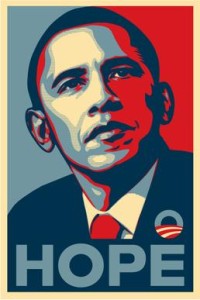Intellectual property law is something I find very interesting — especially where it intersects with more philosophical concerns surrounding what it means to be creative and how (or if) works of art contain meaning and communicate intent.
So it is with great interest that I listened to an NPR show devoted to the brewing legal controversy surrounding Shephard Fairey’s iconic Barack Obama “Hope” poster. I’m sure you’re familiar with the image, which looks like this:

The background on this is that Shephard Fairey is a “street artist” whose work primarily consists of re-appropriated and re-contextualized images — if you’ve ever seen the Andre the Giant “Obey” sticker, that’s Shephard Fairey.
Anyway, when Fairey created the Obama poster, he used an A.P. photograph for reference, about which Fairey has always been upfront. But recently the photographer who took the photo, Mannie Garcia, found out it was his and now both he and the A.P. want to get paid.
Fairey, meanwhile, says his re-appropriation of the image is “fair use,” which is to say he’s allowed to use it under U.S. copyright law in this manner without paying or obtaining permission from the copyright holder. The use, Fairey argues, is fair because (among other things) his poster transforms the photo from its original purpose (to document a “Save Darfour” event) to a new one (to portray Barack Obama as politically inspirational).
This, of course, opens up a whole can of worms. Let’s assume Fairey did nothing to the image — he merely inserted it into his poster layout. Can this constitute a transformation? Our first instinct is to say no. Yet my inclusion of the image in this post doesn’t alter the poster in any way and my use is almost certainly fair.
Ah, but Fairey says he did alter the image… which is obvious enough; the poster is stylized and the photo is not. If we imagine that Fairey looked at the photo and then created his poster out of whole cloth using the photo as a reference (as many painters do), we would probably say that Fairey did something rather creative. But would we feel differently if he “just” ran it through a Photoshop filter?
Another way to look at it: let’s imagine Fairey was able to pose Obama in exactly the same way as the original photo, in the exact same place, under the exact same lighting conditions, used the exact same camera, lens and settings and ultimately created a photo that looked 100% identical to Mannie Garcia’s photo — would Fairey have violated Garcia’s copyright?
Fairey makes it out that he is a Fair Use crusader in all of this, and as someone who has been disenchanted by our copyright system’s inability to adapt to the realities of the internet age, I wish that he was. But Fairey is involved in another Fair Use case where he’s on the opposite side.
Baxter Orr — himself a Fairey-esque artist — decided to make a confusingly obtuse “question everything” statement about Fairey’s own obtuse “question everything” statement by placing a surgical mask over Shephard’s iconic “Obey Giant” face.

What did Fairey do? He sent Orr a cease-and-desist order. (Read more here.) Apparently everyone wants to get paid.